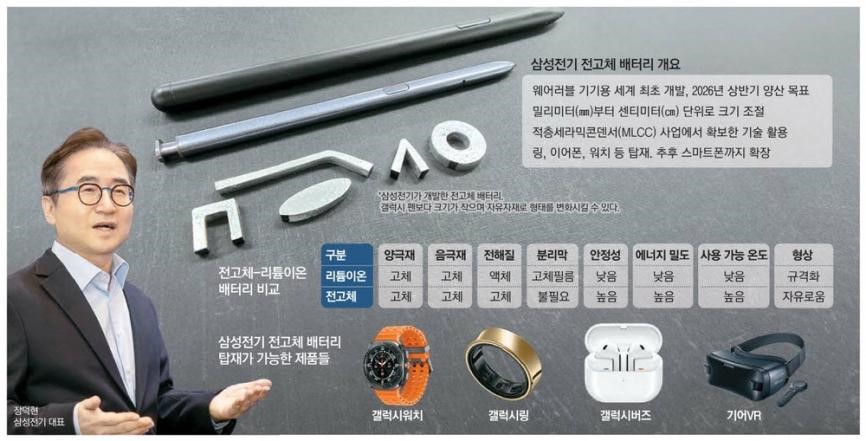At the CES show held on January 13, 2025, Samsung Electro-Mechanics officially unveiled its newly developed prototype of a small solid-state battery with an energy density of 200 Wh/L, which is scheduled to be fully rolled out in 2026. This development marks a critical step in moving solid-state battery technology from laboratory research and development to large-scale adoption. As an emerging energy storage technology, solid-state batteries are regarded as potential alternatives to traditional lithium batteries due to their high energy density, strong safety and flexible structural design. Samsung Electro-Mechanics not only demonstrates its technological prowess, but also provides a new solution for improving the performance of future electronic devices.
Technical analysis: the core advantages of solid-state batteries
Samsung Electro-Mechanics' solid-state batteries use oxide-based solid electrolyte materials with excellent electrochemical performance and high stability. Compared to traditional lithium-ion batteries, these batteries eliminate the need for flammable liquid electrolytes and significantly improve safety, especially in extreme heat or mechanical shock environments, significantly reducing the risk of fire and explosion. In addition, solid-state batteries are designed to be more compact, achieving volumetric energy densities of up to 200 Wh/L by reducing the space between components, which is comparable to the level of today's mainstream lithium batteries.
Samsung Electro-Mechanics has adopted an ultra-compact design that further integrates battery components to improve energy storage efficiency. This design is particularly suitable for small devices with critical size and weight requirements, and can effectively extend their battery life. At the same time, the solid-state electrolyte has a longer cycle life, further enhancing the economy and practicality of the battery.

Pictured: Samsung Electro-Mechanics exhibited a solid-state battery prototype at CES, and wearable devices will be the first to be used
Application scenarios and market potential
The high energy density and miniaturization of solid-state batteries make them show great potential in the field of wearable devices. For example, products such as smartwatches and health trackers require high battery life, and Samsung Electro-Mechanics' new battery is able to meet these needs, thereby improving the user experience. In addition, due to the high safety of solid-state batteries, their application in medical wearable devices such as implantable heart rate monitors and drug delivery devices that require a high degree of stability is also being expected.
In addition, Samsung Electro-Mechanics plans to expand solid-state batteries into other high-performance areas, such as optimizing in server CPUs and AI accelerators using glass-substrate technology. This combination lays the technical foundation for solid-state battery applications in data centers, high-performance computing (HPC), and more. According to market research institutions, the market size of solid-state batteries will exceed 200 GWh by 2030, bringing considerable economic benefits to the industry.
Industry impact: Technological innovation and increased competition
Samsung Electro-Mechanics' solid-state battery prototype is of great significance in the industry. On the one hand, its technological breakthrough will accelerate the commercialization process of solid-state batteries, providing impetus for promoting a new generation of energy storage technology to replace traditional lithium batteries. On the other hand, it has also intensified the competitive landscape within the industry. At present, many companies, including Samsung SDI, LG Chem, Toyota, etc., have increased investment in the research and development of solid-state batteries, and strive to seize the opportunity in the future market.
It is worth noting that the industrialization process of solid-state batteries has not been smooth sailing. Currently, the main challenges facing the industry include:
1. High production costs: Solid-state electrolytes are complex to prepare and process, resulting in significantly higher unit costs than liquid batteries.
2. Solid-solid interface problem: The electrochemical interface resistance inside solid-state batteries is large, which affects its charge-discharge efficiency and power output.
3. Difficulty in large-scale manufacturing: The production equipment and technology of solid-state batteries are not yet fully mature, and need to be further optimized and verified.
These issues require companies to continue to invest in R&D, production processes, and supply chain management to drive solid-state batteries in a more efficient and economical direction.
Prospects and recommendations for the future
Samsung Electro-Mechanics' 200 Wh/L solid-state battery prototype represents a leap forward in small battery technology. With the gradual expansion of the application range, solid-state batteries are expected to become an important part of future energy storage technology, and will be popularized in many fields such as consumer electronics, medical equipment, and industrial automation.
In the future, Samsung Electro-Mechanics needs to focus on solving the following problems:
1. Technology deepening: Further improving battery performance by improving the ionic conductivity of the solid-state electrolyte and optimizing the interface design.
2. Cost control: Promote technological innovation in key materials and production processes to reduce manufacturing costs and enhance market competitiveness.
3. Ecosystem building: Establish partnerships with other companies and research institutions to jointly promote the standardization and industrialization of solid-state batteries.
Conclusion
The release of Samsung Electro-Mechanics' solid-state battery prototype not only brings a new power source to small technology devices, but also injects innovation vitality into the entire energy storage industry. Its high energy density, safety, and flexibility make it a promising application in wearable devices, medical devices, and high-performance computing.
However, to achieve full commercialization of solid-state batteries, companies still need to overcome challenges such as technology, cost, and large-scale production. In the next few years, with the further maturity of technology and the promotion of market demand, solid-state batteries may become the mainstream choice of energy storage technology, opening a new chapter for the global electronic equipment market. We look forward to Samsung Electro-Mechanics continuing to make efforts in this area and bring more breakthroughs to consumers and the industry."






